The Evolution of Smart TVs: From Basic Apps to AI-Powered Hubs

Remember When TV Was Just... TV?
Not too long ago, your television was a one-way street. You sat back, flipped through a handful of channels, and watched whatever was on. Fast forward to today—and you're not just watching TV, you're interacting with it.
So, how did we get here.? How has the evolution of smart tvs happened? It’s a journey that started back in the 1990s. Today, let’s in this blog, explore the journey of Smart TVs—from their early beginnings to their exciting AI-driven future. But, first let’s understand what smart TV is.
What is a Smart TV?

A Smart TV is a television set with internet capabilities. Think of it as a mix between a traditional TV and a smartphone. You can stream shows, install apps, browse the web, and even talk to it. Yup, it listens.
It goes beyond entertainment. Modern Smart TVs allow you to mirror your phone screen, connect with smart devices in your home, play interactive games, or even check your calendar and emails. With software updates, these TVs keep evolving—adding new features over time.
You get content on demand, personalized recommendations, and a smooth user experience—all from a single remote or even your voice. That’s why Smart TVs are called “smart”—because they learn, adapt, and respond to your preferences.
Smart TV Technology Explained: What are the Technology Works Behind Smart TV?
- Operating System: Like Android TV or webOS, it's the software your TV runs on—similar to your phone’s OS.
- App Store: Just like on your smartphone, you can download apps like Netflix, Prime Video, or Spotify.
- Connectivity: Wi-Fi, Bluetooth, HDMI, and even voice control—your TV is connected in every way.
- Processors: Think of this as the TV’s brain. Faster processors mean smoother performance.
A Quick History of Smart TVs

Late 1990s – The Seeds Were Planted
The first concept of internet-enabled TVs emerged. These were experimental and limited in what they could do.
2008 – Samsung Launches the First Real Smart TV
This was the game-changer. Built-in internet connectivity, some interactive functions—it was revolutionary.
2010 – Streaming Becomes Mainstream
Netflix, YouTube, and other apps became staples. Suddenly, you didn’t need a set-top box or a laptop to binge your favorite series.
2012 – Smarter Features Roll In
Voice control, motion sensors, custom app stores, and sleek operating systems made TVs more user-friendly than ever.
Today – Smart TVs Are Household Staples
They're no longer a luxury. In many homes, Smart TVs are the default choice, thanks to their convenience, features, and sheer versatility.
How AI Is Transforming Smart TVs (And Your Viewing Experience)

Artificial Intelligence is supercharging what your Smart TV can do—making it smarter, more responsive, and tailored just for you.
Personalized Content Recommendations
AI studies what you watch—genres, actors, timing—and starts curating your home screen with exactly the type of content you love. Over time, it becomes eerily accurate, reducing the time you spend scrolling.
Built-In Voice Assistants
You no longer need to remember which app has your show. Just say, "Play crime thriller on Netflix," and your TV obeys. With Google Assistant, Alexa, and other built-in voice tools, interacting becomes hands-free and natural.
Picture & Sound Optimization
AI dynamically adjusts display settings—brightness, sharpness, saturation—and sound profiles depending on what you're watching and your room’s lighting. Whether it's a horror movie at night or sports during the day, the view is always optimized.
Context-Aware Intelligence
Modern AI in Smart TVs can detect who's watching and change profiles accordingly. Kids see age-appropriate content, while adults get access to their personalized content universe.
Smart Home Integration
AI-powered TVs also work as a dashboard for your home. Adjust lighting, check your smart fridge, control air conditioning, or even monitor home security—right from your screen.
Accessibility & Multilingual Features
AI is also helping people with different needs—offering voice navigation, real-time subtitles, and language translation features so everyone in the family can enjoy it their way.
AI isn't just a feature—it's the silent engine making your entire viewing and living room experience better, smarter, and seamless.
The Future of Smart TVs: What's Next?
Hyper-Personalization
TVs will become even better at predicting your tastes—not just suggesting shows, but curating entire evenings of content just for you.
Enhanced Interactivity
Think real-time polls during live events, fitness apps that watch your form, or kids’ shows that respond when your child speaks.
AR/VR Capabilities
Immersive viewing is on the horizon. Augmented and Virtual Reality features may soon make your TV a portal into new worlds.
Central Smart Home Hubs
TVs will manage everything from groceries to security, acting as the brains of your connected home.
Glance TV: Making Smart TV Smarter Than Ever
Glance equipped with Generative TV is making your smart TV smarter than ever, by offering:
AI Styling
Glance TV powered with AI allows you to mix and match your favourite outfits and accessories based on your body type, preferences, and trends, through virtual Avatar. So you're not guessing, you're confidently choosing.
AI Recommendations
Glance learns your taste over time, be it your favourite brands, or gadgets—and surfaces suggestions that match your vibe.
One-Tap Shopping
You can buy directly from your TV screen—from brands like Nike, US polo, and more—without switching apps or getting lost in checkout steps.
AI News Updates
Glance also offers you real time news updates, sports scores, and weather right on your smart TV, so you stay updated about everything effortlessly.
Glance is turning your Smart TV into a seamless lifestyle assistant.
Wrap Up
What started as a box for watching scheduled broadcasts is now your entertainment hub, shopping assistant, and smart home command center—all rolled into one.
With AI leading the next chapter, your TV is no longer just a screen—it's becoming a personalized, intelligent companion in your living room.
So, the next time you turn on your Smart TV, remember you're not just watching its evolution—you’re part of it.
FAQs
Which is better, LED or Smart TV?
LED is a display type, while Smart TV refers to features like internet access and apps. Most Smart TVs today use LED screens.
Which is better, Android or Smart TV?
Android TV is a type of Smart TV with Google’s OS. It supports Google Play Store, voice search, and Chromecast. Other Smart TVs use different systems and may have limited apps.
Read more: Smart TV vs Android TV
Can a Smart TV work without the internet?
Yes, a Smart TV works without internet for basic functions like HDMI, cable, or USB playback. But streaming apps, voice assistants, and updates won’t work offline. For full smart features, an internet connection is essential.
Does a Smart TV have Bluetooth?
Recent Smart TVs offer Bluetooth to connect headphones, speakers, or remotes wirelessly. However, it’s model-specific—check the specs before buying if Bluetooth connectivity matters to you.
Do Smart TVs have cameras?
Some Smart TVs come with built-in cameras for video calls or motion sensing, but most don’t. If privacy is a concern, choose models without cameras or disable them through settings.
What makes Glance TV different from other Smart TVs?
Glance TV adds an AI layer to your Smart TV, giving real-time, personalized content and styling tips. You can even shop top brands like Nike or Calvin Klein directly—no need to switch apps. It’s interactive, intelligent, and built for daily convenience.



